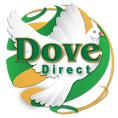Dove Direct Print and Marketing Blog - "The 4 A’s of Personalization"
Welcome to the Dove Direct Print and Marketing Blog. Today's post, "The 4 A's of Personalization," speaks to the ongoing development of personalization as a marketing tool that continues to evolve as consumers come to expect more from brands.
Just as important, the quest for better personalization attributes reaches well beyond the data to genuine, authentic personal communications. Understanding your customer goes a long way toward elevating the customer experience to a level where "pricing to the bottom" is no longer an issue.
Brands can attain deeper relationships with customers when marketing is designed to create an authentic, long-lasting emotional connection with the brand and product set. This deeper customer relationship spans seasons as opposed to quick one-off communication bursts.
The 4 A's
You've heard the adage, "An apple a day keeps the doctor away," and during the educational years, an "A" on a report card typically means enthusiastic parents recognizing an effort for learning and doing well. Today, we'll place a new moniker of sorts on the "A" status theme as it relates to personalization. Hence the 4 A's of Personalization:
- Acknowledge - Customers expect to be addressed by name
- Advise - Customers expect brands to be cognizant of their preferences, pain points, and must-haves, and advise with suitable solutions
- Awareness - Customers expect that the brand is aware of their existence and remembers to communicate with that awareness in mind
- Appropriate - Customers expect relevant offers based on the knowledge of their preferences
One of the first and possibly most important aspect of any business decision should be from the standpoint of how that decision will affect customers. Therefore, the first question on the horizon should be, "How will this decision benefit my customers?" A good rule of thumb for making better business decisions is to play a make-believe scenario, where you imagine your customer is in the room with you as you make a decision that will impact that customer. This process is where the rubber meets the road when it comes to attracting and building customer loyalty. The mindset for putting the customer first represents fertile ground for customer retention over the long haul.
(1) Acknowledge
Acknowledging customers by name is a given. Moreover, while that is an essential attribute in achieving the first rule of personalization, it should not stop there. Collected data has a way of being massaged, sold, and in many cases could end up in a marketing initiative whereby the intended customer set (in part or whole) is offended when they receive an email blast with their name on the greeting. The ramifications of such could result because they have no interest, or have yet to hear about this brand/product or even more noteworthy, they could be turned off by the entire process.
If you are aware of or believe in the 1% Thin Theory, (only 1% of any target group needs the product/service at the time they receive the communication), then blind email blasts could reach the 1% that have an interest. However, "acknowledgment" goes farther than producing the first name for an email blast.
Communication messages that seek to uncover a conversational tone with content that is less about selling and more about gathering information from the prospect or customers will go much further towards establishing personal relationships. Customers react much better to brands looking to uncover what they are genuinely concerned about, and thus opens the door to authenticity. Earnest acknowledgment of what the prospect needs or wants leads to establishing authenticity, which is what customers crave.
(2) Advise
Customers continually seek the advice of subject matter experts, from just about every field and industry sector. This advice-seeking ritual applies to both B2C and B2B organizations. Customers today are much more informed than ever before, and in some cases based on their search efforts, could challenge the best of salespeople. It is important to keep in mind that any advice will be "Googled and Amazon-ed."
Another aspect related to advice is that advice flows in part from data collection, thus making data collection tricky. When obtaining data from disparate, disjointed frameworks, there could be multiple clear and present dangers that place the brand at risk. That risk could be insurmountable, particularly if the brand fails to provide the level of intelligence that customers expect from their brand of choice.
Therefore, smarter data collection results in better customer-focused insights, which in turn elevates the brand's ability to create and offer best in class customer interactions. An adviser approach showcases the brands SME and allows the brand to provide better-targeted solutions.
(3) Awareness
Awareness is a double-edged sword. A brand or marketing organization may demonstrate a keen awareness at the beginning of a customer interactions process. Customers expect a brand not only to be aware of their needs, wants, and preferences at the outset, but also retain these customer preferences as they evolve. In the event, a brand limits its initial customer awareness to the opening data collection; any subsequent communication messaging could be devastating. The aftereffect of a brand failing to update customer preferences, or failure to incorporate updates as part of an ongoing communications platform, can lead to existing customers seeking an alternative brand.
The takeaway here is that customer awareness is an ongoing effort that needs refreshing along the journey. Customers love receiving new marketing messages that showcase how their preferences are evolving, and more importantly, they experience a heightened level of brand loyalty. In short, "Brands that care about me, remember me, and are the brands that I want to do business with."
Lastly, remembering customer preferences in the way customers want to be recalled is based on ongoing awareness updates. To make a point, a bad example of brand awareness is when a customer purchases a product, either online or in a brick and mortar, and then starts to receive several email blasts asking them to buy a product that they just purchased! That's a lack of awareness and tells the customer in a roundabout way, "We don't care about your preferences or purchase history; we only care about selling you something." If this occurs, the message the customer receives is that the brand has no awareness process, or to put it more bluntly, the brand has no awareness of me, the customer!
(4) Appropriate
Customers are driving the revenue vehicle, regardless of what any marketer, brand, or salesperson may believe. In the marketing and communications world of personalization, new and subsequent (up-sell), offers rely on what the customer deems appropriate and relevant. In this sense, what is relevant can be appropriate, but what is appropriate may not be relevant. Let us explain.
We contend that some experts argue that what is relevant and what is appropriate are interchangeable concepts, and in some cases that may be true. However, for the sake of debate, let's look at a lending scenario where the ideas are not interchangeable.
An organization exploring loans to grow a segment of its business reaches out to several financial institutions. Upon receiving several messages at the outset, the organization decides to wait before taking on more debt as the economy shows signs of a downturn. Subsequently, the organization communicates with the top two financial institutions that it will postpone seeking additional finance.
In the aftermath of the loan inquiry, the organization, in a matter of days, begins receiving email blasts every 4-to-6 days asking it to complete the loan process. Is it appropriate to send out marketing messages asking for business when the organization has stated they are not going to pursue a loan at this time? You can make the call, however, we contend that continuing to pursue such an opportunity, after being told that the decision has been postponed, is a bad move because it blatantly ignores the organization's wishes.
Therefore, being relevant is one thing, and being appropriate can yet be quite another. While it is critical to offer relevant communication strategies at all times, it is more important to remain appropriate with relevancy. Customers are always in search of relevant communications as it relates to their preferences, but are more so aware of how brands approach when it is appropriate to trigger the release of the relevant subject matter.
Finally, keep in mind that relevancy continues to evolve. Therefore, when a brand feels it is appropriate to launch a campaign, the relevant portion of the communication should be current and reflect any new customer requirements, as what may have been relevant last month, may have changed.
The Net-Net
By following or incorporating the 4 A's of personalization, brands will raise the probability of better sales, increased brand loyalty, and long term customer relationships. Thanks for reading "The 4 A's of Personalization."
Let's have a conversation about direct mail marketing strategies, printing, transactional documents, variable digital printing, brand equity and unified marketing collateral during our next Open House. We invite you to join us on Thursday, September 26, 2019, for an hour or two, anytime between 10:30 am to 3:30 pm. Let us show you how to improve your document processes to optimize your workflow, reduce your costs, and maximize your organization's printing, letter shop, and mailing capabilities. Dove Direct has an official USPS certified bureau located within our offices that will save you time and money. Moreover, if you bring us your files, we will create a demo file for you. For more information, call Carla Eubanks at 404-629-0122 or email Carla at This email address is being protected from spambots. You need JavaScript enabled to view it..
Dove Direct, your Atlanta based print and mail solutions provider offers organizations end-to-end data, printing, and mailing solutions: Data Management, Variable Digital Printing, LetterShop and Fulfillment, Fully Automated MLOCR Presort Bureau, Marketing and Production Management Support and Secure Data Life Cycle Management.
If you don't want to wait for the Open House, you can reach Dove Direct today by calling 404-629-0122 or use the contact form for Dove Direct.





